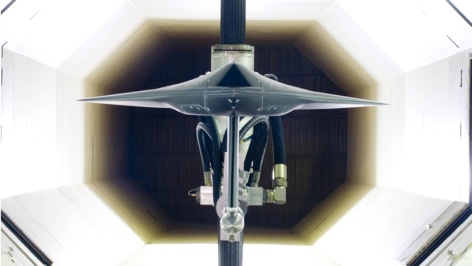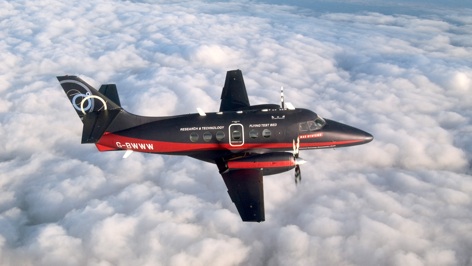
Among the great challenges facing engineers today is that posed by the desire to open up civilian airspace to unmanned aerial systems (UAS). As great challenges go, it doesn’t have the ring or glamour of fusion power or hypersonic flight. This is partly because the technology already exists: UAS are flown extensively by the military in the ‘organised airspace’ of theatres of war. The challenge, however, is to convince the world’s aviation regulators that the technology can be packaged in a way to make it safe for a pilot to ‘fly’ one, maybe two, maybe many aircraft at once, in the same skies as those used by passenger jets, all from a control station on the ground, and even from a different continent.
It is almost inconceivable to think that any regulator would allow a UAS, flown out of the line of sight of its pilot, to come anywhere remotely near an airliner full of people. But if it were proved that the command and control links were reliable, many believe one of the most exciting new markets for aircraft systems worth many billions of pounds could be opened up. That is the goal that British aerospace engineers are now working towards. And if they achieve it, this emerging sector could open up a range of exciting new opportunities for aerospace engineers.
Applications range from fisheries protection, security and border patrol to agriculture, pipeline and rail inspection and perhaps the biggest opportunity of all: the multi-trillion-pound air-cargo market.
Much of the progress in UAS technology continues to be made in the military sphere. But as defence budgets shrink, businesses are looking to apply it more broadly. BAE Systems is working on several large-scale UAS projects primarily for military applications, including the Taranis unmanned combat air system that is due to make its first test flight later this year, and the Telemos project, which is a joint proposal with the French contractor Dassault for a European medium-altitude, long-endurance UAS.
But according to Chris Garside, BAE’s Future Combat Air Systems engineering director, while the military applications for the technology have long been clear, the opportunities for applications in civilian aerospace are only just emerging. He said it was now up to industry to work with the regulators to bring about the future of civilian unmanned flight.
‘We see the market for unmanned technology as one with lots of further potential for growth — particularly with regard to the next generation of unmanned capability as autonomous systems and sensor and payload technology evolve. ‘Until we are able to open up the [civilian] airspace to the satisfaction of the regulators we won’t know exactly what the potential civil uses of this technology will be. We can see some of the practical uses but others will come about because of changes that we haven’t yet considered. That’s why it is important that industry works with the regulators in this area.’
Garside pointed to the ASTRAEA (Autonomous Systems Technology Related Airborne Evaluation & Assessment) programme as an example, under which, in April this year, a BAE Jetstream research aircraft specially adapted to fly in unmanned mode successfully completed a 500-mile trip from Warton, Lancashire, to Inverness, Scotland, under the command of a ground-based pilot and control of NATS (National Air Traffic Control Services) air-traffic controllers. ‘This was part of a series of flight trials designed to prove the technology needed to allow the safe and routine flying of unmanned aircraft in UK airspace.’

Garside added that it was likely that the next generation of unmanned systems would make greater use of autonomy and automated systems as customer requirements shape the future market. ‘The autonomous systems being developed by BAE will actually give humans more time and intelligent and accurate information upon which to make decisions, making them less likely to react in the heat of the moment or without all the facts to hand. In addition, autonomous systems reduce the fatigue and tedium suffered by operators or analysts on duty for hours at a time and required to monitor repetitive data. The systems, which will always be under the command of a skilled operator, will sift through repetitive data and eliminate ‘background noise’, giving operators the ability to make better and more timely decisions.’
According to the Aerospace, Aviation & Defence Knowledge Transfer Network, the commercial potential of autonomous systems as a whole (not just aircraft) for the UK is an ‘untapped’ £7bn. But the total value of the markets in which autonomous systems could play a role is £264bn a year, giving plenty of room for growth.
So how is industry going to make its case to the regulator? The answer lies in testing, testing, testing and more testing, according to Ray Mann, head of the National Aeronautical Centre (NAC).
The NAC, which was formed in a partnership between West Wales Airport in Aberporth and Newquay airport in Cornwall, is the world’s first civilian centre for the operation, testing and evaluation of UAS beyond the visual line of sight. As such, it will provide an essential proving ground for the technology. At its official launch last month (13 September) the keynote speaker was Richard Deakin, chief executive officer of NATS, the leading provider of air-traffic services in the UK, who said the facility provided the UK with the ability to capitalise on what is now recognised as one of the world’s major economic opportunities.
“How is industry going to make its case to the regulator? The answer lies in testing, testing, testing and more testing
Mann echoed this, this week, when he told The Engineer he believed UAS could have a major impact — particularly on the future air-cargo market. ‘I think this is the number one potential. It’s worth $6.4 trillion every year, and if a lot of that was moved to unmanned systems there would be huge cost savings, as well as reducing the environmental impact.’
Mann, a former Rolls-Royce engineer, said since the NAC came into being last year it has attracted a large amount of interest from equipment manufacturers, service providers and businesses in the supply chain. He said there were no limits to the size of aircraft it could accommodate. ‘We can fly anything here, from the size of a cricket ball to a jumbo jet,’ he added.
In fact, Mann believes that the successful application of UAS technology for civilian use will eventually resemble something ‘akin to a passenger airliner rather than a military aircraft’. Indeed, it will have to perform to the same standards of reliability and safety of a manned aircraft. The key difference will be in the systems used to replace the pilot. While UAS will be tailored to meet the requirements of specific missions in terms of their payloads, it is the command and control system that will probably become standardised through the rigorous testing and evaluation work that will be carried out at the NAC.
“We have to be able to guarantee the link [between the ground controller and the aircraft>
Ray Mann, National Aeronautical Centre
Mann said: ‘Command and control is the issue. We have to be able to guarantee the link [between the ground controller and the aircraft]. We have to prove it, stress it and confirm it. We have the technology, but we have got to package it together and demonstrate to the regulator that it works to that level. Our facilities will enable that work.’
The key skills requirements will be precisely in this area, on the electronics and communications side. A view echoed by Garside. ‘This field is a fascinating one, right at the leading edge of current technology, with numerous opportunities across the field of engineering, including aerodynamics, structural, mechanical, systems engineering and integration, as well as test evaluation and certification, training and support,’ he said.




Nanogenerator consumes CO2 to generate electricity
Whoopee, they've solved how to keep a light on but not a lot else.